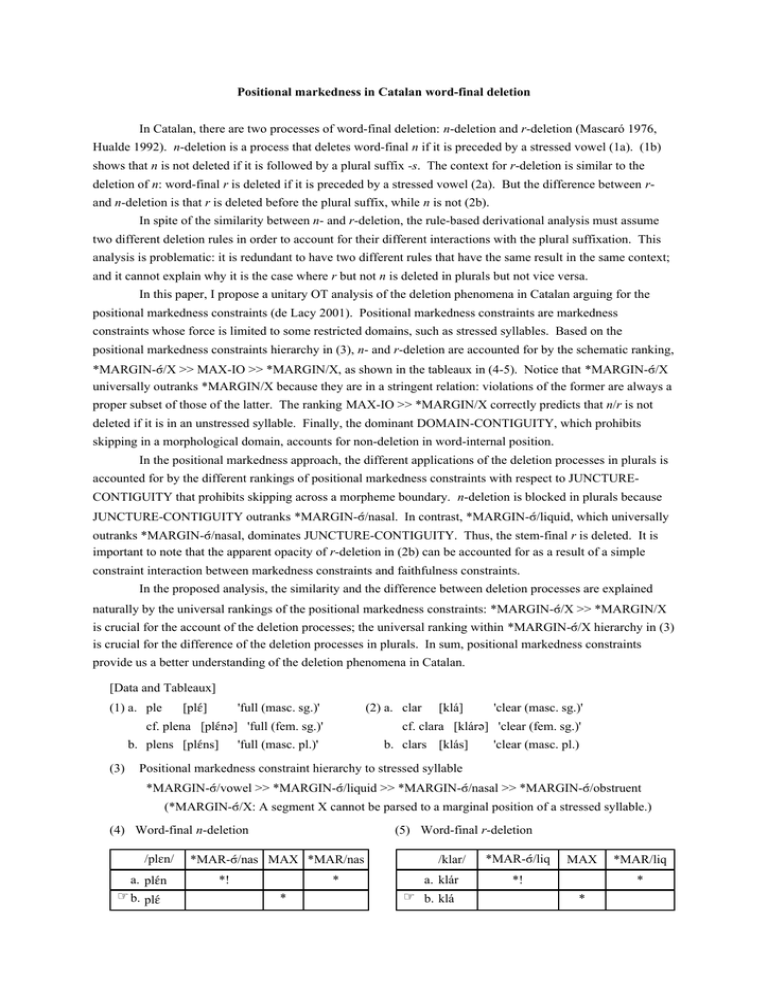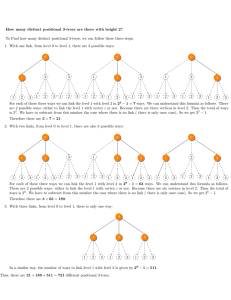n-deletion and
advertisement

Positional markedness in Catalan word-final deletion In Catalan, there are two processes of word-final deletion: n-deletion and r-deletion (Mascaró 1976, Hualde 1992). n-deletion is a process that deletes word-final n if it is preceded by a stressed vowel (1a). (1b) shows that n is not deleted if it is followed by a plural suffix -s. The context for r-deletion is similar to the deletion of n: word-final r is deleted if it is preceded by a stressed vowel (2a). But the difference between rand n-deletion is that r is deleted before the plural suffix, while n is not (2b). In spite of the similarity between n- and r-deletion, the rule-based derivational analysis must assume two different deletion rules in order to account for their different interactions with the plural suffixation. This analysis is problematic: it is redundant to have two different rules that have the same result in the same context; and it cannot explain why it is the case where r but not n is deleted in plurals but not vice versa. In this paper, I propose a unitary OT analysis of the deletion phenomena in Catalan arguing for the positional markedness constraints (de Lacy 2001). Positional markedness constraints are markedness constraints whose force is limited to some restricted domains, such as stressed syllables. Based on the positional markedness constraints hierarchy in (3), n- and r-deletion are accounted for by the schematic ranking, *MARGIN-σ"/X >> MAX-IO >> *MARGIN/X, as shown in the tableaux in (4-5). Notice that *MARGIN-σ"/X universally outranks *MARGIN/X because they are in a stringent relation: violations of the former are always a proper subset of those of the latter. The ranking MAX-IO >> *MARGIN/X correctly predicts that n/r is not deleted if it is in an unstressed syllable. Finally, the dominant DOMAIN-CONTIGUITY, which prohibits skipping in a morphological domain, accounts for non-deletion in word-internal position. In the positional markedness approach, the different applications of the deletion processes in plurals is accounted for by the different rankings of positional markedness constraints with respect to JUNCTURECONTIGUITY that prohibits skipping across a morpheme boundary. n-deletion is blocked in plurals because JUNCTURE-CONTIGUITY outranks *MARGIN-σ"/nasal. In contrast, *MARGIN-σ"/liquid, which universally outranks *MARGIN-σ"/nasal, dominates JUNCTURE-CONTIGUITY. Thus, the stem-final r is deleted. It is important to note that the apparent opacity of r-deletion in (2b) can be accounted for as a result of a simple constraint interaction between markedness constraints and faithfulness constraints. In the proposed analysis, the similarity and the difference between deletion processes are explained naturally by the universal rankings of the positional markedness constraints: *MARGIN-σ"/X >> *MARGIN/X is crucial for the account of the deletion processes; the universal ranking within *MARGIN-σ"/X hierarchy in (3) is crucial for the difference of the deletion processes in plurals. In sum, positional markedness constraints provide us a better understanding of the deletion phenomena in Catalan. [Data and Tableaux] (1) a. ple [pl'"] 'full (masc. sg.)' (2) a. clar cf. plena [pl'"n´] 'full (fem. sg.)' b. plens [pl'"ns] (3) [klá] 'clear (masc. sg.)' cf. clara [klár´] 'clear (fem. sg.)' 'full (masc. pl.)' b. clars [klás] 'clear (masc. pl.) Positional markedness constraint hierarchy to stressed syllable *MARGIN-σ"/vowel >> *MARGIN-σ"/liquid >> *MARGIN-σ"/nasal >> *MARGIN-σ"/obstruent (*MARGIN-σ"/X: A segment X cannot be parsed to a marginal position of a stressed syllable.) (4) Word-final n-deletion /pl'n/ a. pl'"n ☞ b. pl'" (5) Word-final r-deletion *MAR-σ"/nas MAX *MAR/nas *! * * /klar/ a. klár ☞ b. klá *MAR-σ"/liq MAX *! *MAR/liq * *



